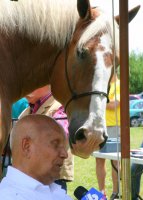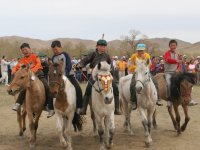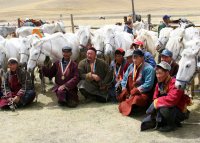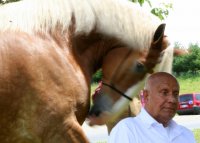Horse sense
Friday, February 20th, 2009Perhaps many people believe that you need to have a lot of experience with horses in order to be able to assist them when they are unwell or ailing.
Whilst this is of unquestionable benefit in many cases, I have discovered that it is not entirely so. In fact, in some cases where people have a lot of experience with handling horses they are sometimes blind to the true nature of their charge.
A horse may even be sick expressly for the purpose of trying to get a different pattern established in these people. My colleague Mike Bascombe describes them to be our ‘great teachers’, in this regard.
It is also easy to see why some of us may feel intimidated by horses. Their size alone can be enough to make us nervous around them and even those of us who grew up with horses in the family were always taught to let them know you were there in case they took fright and hurt you accidentally. I used to always love their smell and their soft ears and muzzles but I never really identified with them.
Their size alone can be enough to make us nervous around them and even those of us who grew up with horses in the family were always taught to let them know you were there in case they took fright and hurt you accidentally. I used to always love their smell and their soft ears and muzzles but I never really identified with them.
I never really felt totally relaxed with them owing to my perception of their unpredictability and had always identified them as ‘prey’. Their intelligence and wisdom was wholly underappreciated.
Fortunately the horse is blessed with one of the most amazingly biggest hearts in the animal kingdom. And more fortunately, things can change.
I was a little surprised to find that Sri Chinmoy in his ‘Animal Kingdom’ refers to the horse as sacrifice. Reflecting on what this could mean I was overwhelmed with the realisation that horses really are servants to mankind in many ways. I am used to thinking of the sacrificial qualities of sheep and cows as they give up their lives for us but I had never considered that a horse’s soul’s quality would be sacrifice.
He writes:
Horse, my horse,
I envy you.
I mean it, I really do.
Your life of constant and complete
sacrifice
Is far beyond the height
Of all earthly and heavenly price.
God barters His Eternity’s
Heart-Gratitude
With your immortality’s
sacrifice-plenitude.
After you have been fortunate enough to be engulfed by the vastness and power of a horses heart it may be easier to understand that they do sacrifice themselves in a way in order to teach us that the universe is bigger than we can imagine. It is quite a humbling experience to be in their space when they let you in like this.
I am often asked whether I work with horses.
Any horse can tell that I have not been used to handling them much and that they can nearly always get the better of me if they wish. That, however, does not stop me being able to help them should they allow me. 
I have begun to understand that they need me to ask them to allow me to help them. They do also need the boundaries established in order for them to feel safe.
Horses are their own best healers like the rest of us. Furthermore, they have big enough hearts to assist us to heal ourselves as well in many situations and horses that have been treated well are more likely to come into this position of being. That does not mean that they don’t suffer or not get sick. At these times there has been something to disrupt the flow of life energy that keeps them well and they often need help to overcome these obstacles.
We will see this occasionally in situations where the horses are being used or overused in activities requiring them to be compromised by ill fitting saddles or disrespectful handlers for example. They will also be made sick by being stuck in unhealthy environments, as their connection to the land is strong and influential to their wellbeing. There are cases of illthrift in horses as a result of them being stuck in a geographic ‘hole’ or pocket of negative earth energy. Needless to say, they are also affected by their connections to their owners and families and like many domestic animals, they can take on the emotional ill health of their people or other animals close to them. They are, of course, also going to be as prone as the rest of us to outbreaks of infectious diseases when epidemics occur. The means of healing them in these situations will largely depend on the informed choices and personal convictions of those entrusted with their care.
There is a host of health practitioners who do great work with horses from chiropractors, positional release therapists , farriers, vets, natural healers and homeopaths. I have made many new acquaintances over recent times who have taught me much about the array of approaches that are conducive to healing horses. One of the most important techniques that engenders freedom and good health is sound management practices. Natural horsemanship such as made famous by Pat Parelli and others, is highly regarded as a strong foundation for optimally healthy horses. Good nutrition would rate equally highly here along with proper foot care and saddle fitting.
 It seems that whilst horses are still found roaming wild in many places of the world, they adapt and thrive very well in our domestic environments. It seems that we have much to offer each other and that the arrangement, if well managed, can be mutually beneficial.
It seems that whilst horses are still found roaming wild in many places of the world, they adapt and thrive very well in our domestic environments. It seems that we have much to offer each other and that the arrangement, if well managed, can be mutually beneficial.
Please feel free to contact me for more information about the practitioners available to Geelong and Western Victorian horses in this regard.
And if you haven’t said hello to a horse recently, go and make a good friend!





